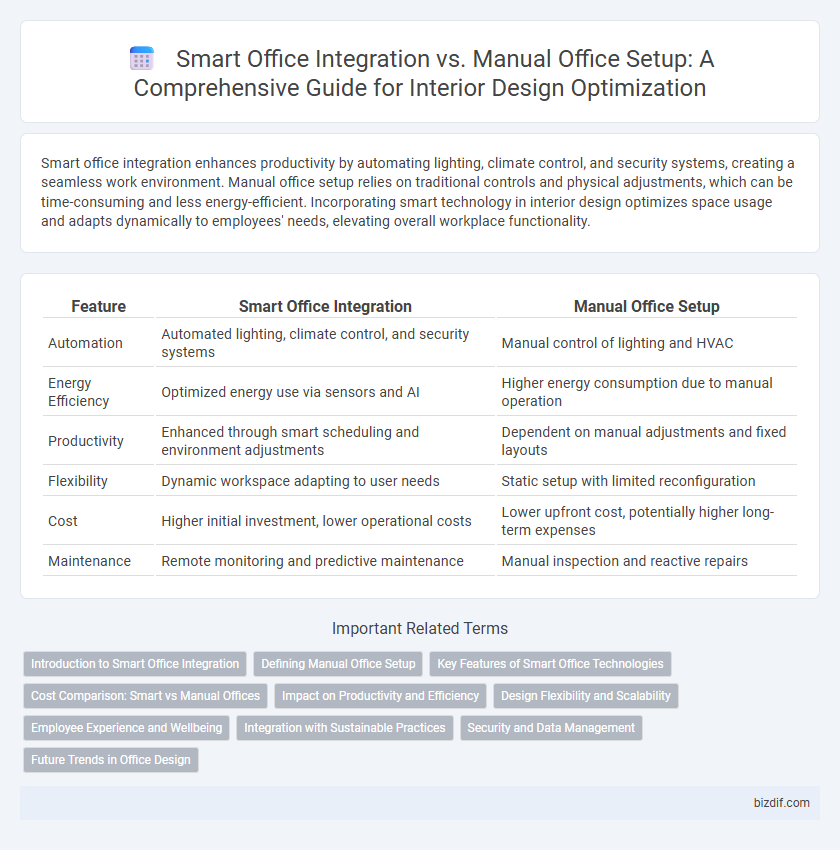Smart office integration enhances productivity by automating lighting, climate control, and security systems, creating a seamless work environment. Manual office setup relies on traditional controls and physical adjustments, which can be time-consuming and less energy-efficient. Incorporating smart technology in interior design optimizes space usage and adapts dynamically to employees' needs, elevating overall workplace functionality.
Table of Comparison
| Feature | Smart Office Integration | Manual Office Setup |
|---|---|---|
| Automation | Automated lighting, climate control, and security systems | Manual control of lighting and HVAC |
| Energy Efficiency | Optimized energy use via sensors and AI | Higher energy consumption due to manual operation |
| Productivity | Enhanced through smart scheduling and environment adjustments | Dependent on manual adjustments and fixed layouts |
| Flexibility | Dynamic workspace adapting to user needs | Static setup with limited reconfiguration |
| Cost | Higher initial investment, lower operational costs | Lower upfront cost, potentially higher long-term expenses |
| Maintenance | Remote monitoring and predictive maintenance | Manual inspection and reactive repairs |
Introduction to Smart Office Integration
Smart office integration incorporates IoT devices, automated lighting, climate control, and AI-driven workspace management to enhance productivity and energy efficiency. Unlike manual office setups that rely on traditional furnishings and disconnected systems, smart offices enable seamless communication between devices, allowing real-time adjustments tailored to employee preferences. This technology-driven approach supports flexible work environments and reduces operational costs through advanced data analytics and automated maintenance schedules.
Defining Manual Office Setup
Manual office setup involves arranging furniture, lighting, and equipment in a workspace through traditional methods without the use of automated technologies or smart devices. It requires physical adjustments and hands-on management to optimize spatial efficiency, comfort, and workflow within the office environment. This approach emphasizes human control over design elements, relying on manual coordination rather than integrated digital systems for functionality and ambiance.
Key Features of Smart Office Technologies
Smart office integration enhances workspace functionality through automated lighting, climate control, and intelligent scheduling systems, optimizing energy efficiency and employee comfort. Advanced sensors and IoT connectivity enable real-time data analytics for space utilization and occupancy management, significantly improving operational workflows. These technologies support seamless device synchronization and remote management, setting a new standard compared to traditional manual office setups reliant on static configurations.
Cost Comparison: Smart vs Manual Offices
Smart office integration typically requires higher upfront investment due to technology costs such as IoT devices, automated systems, and software licensing, whereas manual office setups involve lower initial expenses focused on traditional furnishings and basic infrastructure. Over time, smart offices can reduce operational costs through energy efficiency, predictive maintenance, and enhanced productivity, potentially offsetting their initial outlay. Manual offices may incur higher long-term costs related to inefficient energy use, increased maintenance, and less optimized space utilization.
Impact on Productivity and Efficiency
Smart office integration leverages IoT devices and automated systems to streamline workflows, significantly boosting productivity and operational efficiency. Manual office setups often lead to time-consuming adjustments and limited adaptability, hindering seamless collaboration and resource management. Implementing smart technology in office design maximizes space utilization and optimizes environmental controls, resulting in enhanced employee performance and reduced downtime.
Design Flexibility and Scalability
Smart office integration offers unparalleled design flexibility and scalability by enabling seamless adjustments to workspace configurations through automated systems and IoT devices, allowing dynamic adaptation to changing needs. Manual office setups often face limitations in scalability and require significant physical modifications to adjust layouts, restricting long-term flexibility. Leveraging smart technology in interior design not only streamlines space optimization but also supports future growth with minimal disruption.
Employee Experience and Wellbeing
Smart office integration enhances employee experience by creating adaptive workspaces that automatically adjust lighting, temperature, and ergonomics to individual preferences, boosting comfort and productivity. Manual office setups often lack this personalized environment, leading to increased physical strain and decreased overall wellbeing. Incorporating IoT devices and sensor technology promotes healthier, more engaged teams through data-driven workspace optimization.
Integration with Sustainable Practices
Smart office integration seamlessly combines advanced technology with sustainable design elements, reducing energy consumption and optimizing resource efficiency. Automated lighting, climate control, and sensor-based systems minimize waste while enhancing employee comfort, supporting both environmental goals and productivity. Manual office setups often lack the precision and adaptability needed to fully implement eco-friendly practices, resulting in higher operational costs and environmental impact.
Security and Data Management
Smart office integration enhances security through centralized access controls, real-time monitoring, and automated data encryption, reducing vulnerabilities common in manual setups. Manual office setups often rely on disparate security protocols and physical barriers, increasing the risk of data breaches and unauthorized access. Advanced IoT devices and cloud-based management systems in smart offices enable seamless data protection and efficient incident response, ensuring higher overall security compliance.
Future Trends in Office Design
Smart office integration leverages IoT devices, AI-driven systems, and automated environments to create adaptive workspaces that enhance productivity and employee well-being, setting the foundation for future office design. Manual office setups rely on fixed furniture and traditional layouts that lack flexibility and dynamic response to user needs, rendering them obsolete in evolving hybrid and remote work models. Emerging trends emphasize smart, sustainable, and modular office designs that foster collaboration, energy efficiency, and seamless technology integration.
Smart Office Integration vs Manual Office Setup Infographic

 bizdif.com
bizdif.com